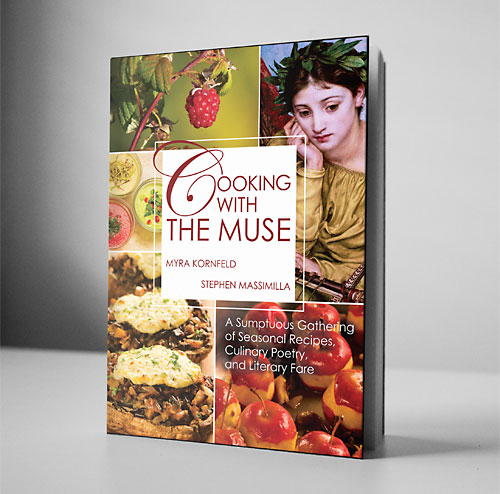ENJOY SUMMER’S OFFERING

Share this Post
Tuscan Roasted Tomato Soup with Parmesan-Gruyère Frico
This soup is an ode to deep, rich, roasted tomato flavor, the fiery rapture of summer when tomatoes are at their peak. Neruda noted that at the height of summer the light of the city is halved like a tomato, its juices running through the streets, into the kitchen, and everywhere. Oil, that essential child of the olive, adds depth, and salt adds magnetism to the wedding of flavors. Though some versions of this soup are thickened with bread, a little bit of rice creates an even creamier texture—and also happens to make this dish gluten free. Use the Parmesan-Gruyère cheese crisp (the frico) as a “dipping spoon” to lap up the orange pleasure, or crumble the frico into the soup for a flavor-enhancing marriage.
Makes 6 to 8 cups soup and 10 to 12 fricos; serves 4
_
SOUP
2 cups thin sauté-sliced onions (page 35)
2 1/2 pounds tomatoes
4 garlic cloves, peeled
1/4 cup extra virgin olive oil
Salt
2 cups vegetable stock
2 tablespoons long-grain white rice
1/2 cup roughly chopped fresh basil
Freshly ground black pepper
Parmesan-Gruyère Frico
2 ounces Parmesan cheese, grated on the large holes of a box grater
2 ounces Gruyère cheese, grated on the large holes of a box grater
1. Preheat the oven to 375ºF.
2. Lay the onions in an 8 by 11-inch baking dish. Core and quarter the tomatoes and lay them on top of the onions. Distribute the garlic around the tomatoes, drizzle the oil on top and sprinkle with 3/4 teaspoon salt. Bake for 45 minutes, until the tomatoes are shriveled.
3. Transfer the onions, tomatoes, and garlic with all of the accumulated juices to a blender and buzz until smooth.
4. While the tomatoes are roasting, add the rice to the stock in a medium pot and bring to a boil. Lower the heat and simmer, covered, until the rice is cooked, about 15 minutes.
5. Transfer the rice and stock to the blender with the tomatoes and buzz everything together until smooth. Return the soup to the pot and set aside.
6. Make the fricos: Mix together the cheeses. Sprinkle a 3-inch disk of cheeses in a nonstick skillet over medium heat, overlapping the shreds of cheese so that they can melt together; but don’t pile them too thick. If your skillet is large, you may be able to make a few of these at the same time. Cook until the cheeses are melted, bubbling, and golden; turn off the heat.
7. When the frico is cool enough to touch, a minute or two after the bubbling has slowed, lift it and transfer to a plate. Continue making the fricos until there is no more cheese. (You should have 10 to 12 in total.)
8. Bring the soup to a boil, then lower the heat and simmer for 10 minutes to marry flavors.
9. Add the basil and a sprinkling of pepper, and simmer for 5 minutes more. Taste, and add a pinch more salt if necessary.
10. Serve the soup hot, with one frico sticking out of the soup like a fin and one on the side.
Poet’s Note
Both as a species and a food, tomatoes were cultivated many hundreds of years before Christ. Even though tomatoes originated in South America, it was not the Incas but the Mayas over 1000 miles to the north who first took interest in them. The word “tomato” derives from the Nahuatl word tomatl. The Pueblo people associated the ingestion of tomato seeds with the power of divination.
Though Cortés and company brought tomatoes back to Europe, they took a while to catch on there too. There is no mention of them until 1544, at which point the Italian botanist Mattioli named a yellow tomato pomo d’oro (“golden apple”); the Italian word for any tomato is still pomodoro. It was also known by a series of more derogatory nicknames, such as “wolf peach,” until it was dubbed the “apple of love” in the late 16th century. It is said that the French mistook the term pomo d’oro for pomo d’amore.
The first real culinary mention of the tomato in Italy was in 1548, when the house steward of Cosimo de’ Medici, the grand duke of Tuscany, wrote with relief that the basket of tomatoes sent from the duke’s Florentine estate had arrived safely. The Tuscans had a head start in developing good tomato recipes, and that’s why we’re featuring a Tuscan-style Roasted Tomato Soup.
Tomatoes were first eaten by Europeans in what we now call salsa, a dish originally developed by the Aztecs. Perhaps because they were called “love apples,” American Puritans considered tomatoes an abomination. Hundreds of years later, most Americans still considered them poisonous. It wasn’t until the mid-19th century that tomatoes brought back to America by Italian immigrants really caught on; we owe their ubiquity to the popularity of Italian food as well as to the breeds developed by Alexander W. Livingston.
_
DIACHRONIC TOMATO
Forget the pink-speckled
pickled moon.
On the table beaming
into mouth-moistening
summer, who favors
the heirloom genuflects, traces
its litmus: time for
the sun’s red fruit.
I split this globe—
the popped seeds,
spurt of stars in
the evening air,
echoing the glittering
day, the sea
of heated leaves,
the stems fuzzed and hot
as the simmering noon,
slosh of olives
and basil in the pot,
enemy of snow,
the tomato,
high esteem of the vine,
the ripened eye,
the sun-red bite,
juice glimmering
on our lips,
the happy murder,
what we cannot
even speak,
molten hemispheres
of bleeding flesh
in their skins.
— Stephen Massimilla —
TELL YOUR FRIENDS!





